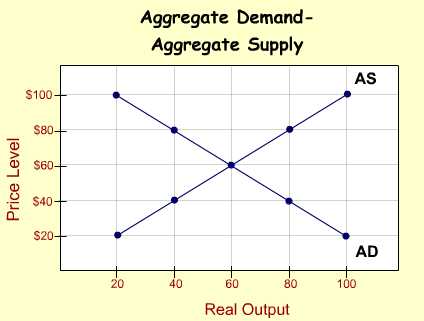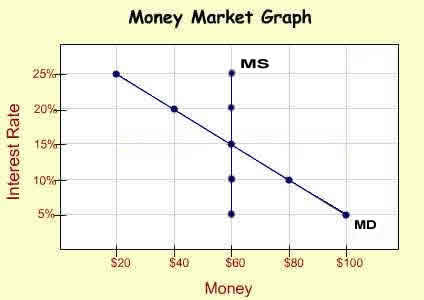Fiscal and Monetary Policy Process and Interactive Quiz

Students follow each step of fiscal and monetary policy processes, to see the logic of how these tools are used to correct economic instability.
Introduction
 As the American economy slid into recession in 1929, economists relied on the Classical Theory of economics, which promised that the economy would self-correct if government did not interfere.
As the American economy slid into recession in 1929, economists relied on the Classical Theory of economics, which promised that the economy would self-correct if government did not interfere.
But as the recession deepened into the Great Depression and no correction occurred, economists realized that a revision in theory would be necessary. John Maynard Keynes developed Keynesian Theory, which called for government intervention to correct economic instability. One of the most important functions of our government today is to try to correct inflation and recession in our economy.
Learning Objectives
- Identify the tools of fiscal and monetary policy.
- Explain how economic stabilization tools affect the money supply, interest rates, and aggregate demand.
- Analyze economic data to determine how fiscal and monetary policy should be used to correct economic problems.
Resource List
- Major Schools of Economic Theory: This web site of the Federal Reserve Bank of San Francisco describes major economic theories and the two tools of fiscal policy.
www.frbsf.org/publications/education/greateconomists/grtschls.html#A8 - Federal Reserve Bank of San Francisco: This web site of the Federal Reserve Bank of San Francisco describes the three tools of monetary policy.
www.frbsf.org/publications/federalreserve/fedinbrief/guides.html - Federal Reserve Bank of Boston Speeches: Asset Bubbles and Systemic Risk: This website provides information on monetary policy during the 2001 recession and the results of the government action that was implemented.
https://www.bostonfed.org/news-and-events/speeches/asset-bubbles-and-systemic-risk.aspx - Federal Reserve Release; Press Release: This Federal Reserve web site explains how the Federal Reserve used monetary policy to help resolve the 2001 recession.
https://www.federalreserve.gov/BoardDocs/Press/General/2001/20011002/default.htm - Self Check Activity: Students can analyze economic problems to determine how fiscal and monetary policies should be used to correct economic problems in this activity.
Self Check Activity
Process
| Economic performance can be illustrated through the concepts of aggregate supply and aggregate demand. Aggregate supply is the total supply of goods and services produced in the nation’s economy. It is upward-sloping because at higher prices firms have an incentive to produce more, and at lower prices they are likely to produce less. Aggregate demand is the total demand for goods and services in the nation’s economy. It is downward-sloping because at higher prices, consumers, firms, government, and foreign customers are less willing to buy, while they will likely buy more at lower prices. Aggregate supply and demand are shown in the graph below. Shifts in the aggregate supply and aggregate demand curves can illustrate changes in the performance of our economy. If consumer confidence in the economy falls and people reduce their spending, aggregate demand can fall, reducing real output and prices and possibly dropping the country into a recession. However, if the money supply is too large, excessive consumer demand can push up the aggregate demand, raising real output and prices and possibly pushing the country into serious inflation. |
 |
Economists generally look to annual goals of GDP growth of 2.5-3 percent, an inflation rate of 3-4 percent, and an unemployment rate of approximately 5 percent for stable economic growth. However, our economy generally follows an economic cycle of recession and expansion every few years. As John Maynard Keynes argued in his 1936 book General Theory of Employment, Interest, and Money, nations need not wait for potential economic problems to correct themselves. He advocated that government take an active role in resolving economic issues through the use of two policies: fiscal policy and monetary policy.
Fiscal policy is the use of government spending and taxes to stabilize the economy. Read the brief explanation of fiscal policy under the “Keynesian School” heading at the Federal Reserve Bank of San Francisco website.
Keynes recommends that, during periods of recession, Congress should increase government spending in order to “prime the pump” of the economy. At the same time, he recommends, Congress should decrease taxes in order to give households more disposable income with which they can buy more products. Through both methods of fiscal policy, the increase in aggregate demand stimulates firms to increase production, hire workers, and increase household incomes to enable them to buy more. Keynes advocates the opposite positions during times of rapid inflation. In order to slow down the economy, Keynes calls for Congress to reduce government spending in order to reduce pressure on aggregate demand. For the same reason he calls for tax increases in inflationary times, to reduce consumers’ disposable income. The reduction in aggregate demand brought about by such actions leads firms to produce fewer products, slows hiring, and reduces inflationary pressure. While both tools are effective, Keynes advocated change in government spending as the more effective fiscal policy tool, because any change in government spending has a direct effect on aggregate demand. However, if taxes are reduced, consumers most likely will not spend all of their increase in disposable income; they are likely to save some of it. In the same way, if taxes are raised, consumers are not likely to reduce their consumption of products by the same amount as the tax; they are likely to dip into savings to cover some of the change in tax rates.
- According to Keynes, what should the government do to taxes and government spending during a time of recession? [According to Keynes, the government should reduce taxes and increase government spending during a time of recession.]
- According to Keynes, what should the government do to taxes and government spending during a period of rapid inflation? [According to Keynes, the government should increase taxes and reduce government spending during a period of rapid inflation.]
| Monetary policy is the use of the money supply and credit to stabilize the economy. Read the explanation of monetary policy and refer to the graph below.
The demand for money consists of consumers borrowing for such items as cars and homes, firms borrowing for such items as factories and equipment, and the government borrowing to finance the national debt. The supply of money is set by the Federal Reserve Board of Governors, the central banking system for the United States. The supply and demand for money determine the interest rate that must be paid for the use of borrowed money. So if the Federal Reserve increases the money supply, interest rates will fall, making it less expensive to borrow money. In that case, those wishing to borrow money will be more likely to do so, and be more likely to spend that money on products. If the Federal Reserve reduces the money supply, interest rates will rise, so less will be borrowed and spent (because of the higher cost of borrowing). |
 |
The Federal Reserve has three primary tools available to change the money supply. First, during periods of recession, Keynes recommends that the Fed buy bonds on the open market. By increasing the reserves the banks hold, the banks have more money available to loan and can reduce their interest rates. At lower interest rates, consumers and firms are more willing to borrow to make purchases, and aggregate demand can increase. Secondly, Keynes recommends that the Fed lower the discount rate. When the Fed reduces the interest rate member banks must pay to borrow from the Fed, banks become more willing to borrow, to make money available for loans at lower interest rates. In this case, again, consumers and firms are more willing to borrow and spend, increasing aggregate demand. Third, Keynes recommends that the Fed reduce the reserve requirement during a serious recession. If banks are allowed to release more of their reserved funds for loans, the lowered interest rate will again entice consumers and firms to borrow funds to make purchases, increasing the aggregate demand. Keynes advocates the opposite positions during times of rapid inflation: reducing the money supply to raise interest rates, making it less likely that consumers and firms will borrow to purchase products.
- How can the Federal Reserve use the reserve requirement, the discount rate, and open market operations during a time of recession? [The Federal Reserve can reduce the reserve requirement, reduce the discount rate, and buy bonds during a time of recession.]
- How can the Federal Reserve use the reserve requirement, the discount rate, and open market operations during a period of rapid inflation? [The Federal Reserve can increase the reserve requirement, increase the discount rate, and sell bonds during a period of rapid inflation.]
While these three tools work in similar ways, they differ in the power of their effects. The reserve requirement is extremely powerful and is changed only in the event of a serious economic problem. The discount rate is used more as a signal of the Fed’s intentions for monetary policy. Open market operations are by far the most widely used tool of monetary policy.
Analyze economic problems to determine how fiscal and monetary policies should be used to correct economic problems in the Self Check Activity. The questions are written below, with the correct answer in italics.
Use the fiscal policy of taxes to solve a recession.
- What does Congress need to do to aggregate demand?
A. Increase aggregate demand [CORRECT]
B. Reduce aggregate demand - What should Congress do to taxes to change the aggregate demand?
A. Increase Taxes
B. Reduce taxes [CORRECT] - How will this change in taxes affect consumers’ disposable income?
A. Disposable income increases [CORRECT]
B. Disposable income is reduced - How will this change in disposable income affect consumer spending in the economy?
A. Spending increases [CORRECT]
B. Spending is reduced
Use the monetary policy of open market operations to solve a recession.
- What does the Federal Reserve need to do to aggregate demand?
A. Increase aggregate demand [CORRECT]
B. Reduce aggregate demand - What does the Fed need to do to the money supply to change the aggregate demand?
A. Increase the money supply [CORRECT]
B. Reduce the money supply - What should the Fed do to bonds to change the money supply?
A. Buy bonds [CORRECT]
B. Sell bonds - How will this bond action affect the reserves available for loan at banks?
A. Increase reserves [CORRECT]
B. Reduce reserves - How will this change in the money supply affect interest rates?
A. Increase interest rates
B. Reduce interest rates [CORRECT] - How will this change in interest rates affect the amount of money borrowed?
A. Increase borrowing [CORRECT[
B. Reduce borrowing - How will this change in borrowing affect consumer spending in the economy?
A. Spending increases [CORRECT]
B. Spending is reduced
Use the fiscal policy of government spending to solve inflation.
- What does Congress need to do to aggregate demand?
A. Increase aggregate demand
B. Reduce aggregate demand [CORRECT]
- What should Congress do to government spending to change the aggregate demand?
A. Increase government spending
B. Reduce government spending [CORRECT] - How will this change in aggregate demand affect firms’ production and employment of workers?
A. Production and employment increase
B. Production and employment fall [CORRECT] - How will this change in production and employment affect consumers’ disposable income?
A. Disposable income increases
B. Disposable income is reduced [CORRECT] - How will this change in disposable income affect consumer spending in the economy?
A. Spending increases
B. Spending is reduced [CORRECT]
Use the monetary policy of the discount rate to solve inflation.
- What does the Federal Reserve need to do to aggregate demand?
A. Increase aggregate demand
B. Reduce aggregate demand [CORRECT] - What does the Fed need to do to the money supply to change the aggregate demand?
A. Increase the money supply
B. Reduce the money supply [CORRECT] - What should the Fed do to the discount rate to change the money supply?
A. Increase the discount rate [CORRECT]
B. Reduce the discount rate - How will this discount rate change affect the willingness of banks to borrow from the Fed and make reserves available for loan at banks?
A. Increase reserves
B. Reduce reserves [CORRECT] - How will this change in the money supply affect interest rates?
A. Increase interest rates [CORRECT]
B. Reduce interest rates - How will this change in interest rates affect the amount of money borrowed?
A. Increase borrowing
B. Reduce borrowing [CORRECT] - How will this change in borrowing affect consumer spending in the economy?
A. Spending increases
B. Spending is reduced [CORRECT]
Use the monetary policy of the reserve requirement to solve inflation.
- What does the Federal Reserve need to do to aggregate demand?
A. Increase aggregate demand
B. Reduce aggregate demand [CORRECT] - What does the Fed need to do to the money supply to change the aggregate demand?
A. Increase the money supply
B. Reduce the money supply [CORRECT] - What should the Fed do to the reserve requirement to change the money supply?
A. Increase the reserve requirement [CORRECT]
B. Reduce the reserve requirement - How will this reserve requirement change affect the reserves available for loan at banks?
A. Increase reserves
B. Reduce reserves [CORRECT] - How will this change in the money supply affect interest rates?
A. Increase interest rates [CORRECT]
B. Reduce interest rates - How will this change in interest rates affect the amount of money borrowed?
A. Increase borrowing
B. Reduce borrowing [CORRECT] - How will this change in borrowing affect consumer spending in the economy?
A. Spending increases
B. Spending is reduced [CORRECT]
Conclusion
Economists learned much from the experience of the Great Depression, and most economists today advocate a role for government in creating economic stabilization policy. Although economists may disagree about which particular tool is most appropriate, or the timing or strength of the tool to be used, most economists recognize the advantages of using fiscal and monetary policy for the prevention of extreme inflation or depression in our economy.
Assessment
In 2001, the U.S. economy slipped into recession. The GDP dropped by more than a 1 percent annual rate in the third quarter, the inflation rate dropped to below a 2 percent annual rate in the fourth quarter, and the unemployment rate rose to 5.6 percent in the fourth quarter. As an economic advisor to the Congress and the Federal Reserve, what would you suggest Congress should do with its tools of fiscal policy, and what would you propose that the Fed do with its tools of monetary policy? Write a paragraph explaining your recommendations, being sure to describe how the tools will work to help improve aggregate demand.
After you have finished, visit the following two web sites to see the fiscal policy action taken by the President and Congress, and the monetary policy action taken by the Federal Reserve to resolve the 2001 recession. Did the government’s action agree with your recommendations?